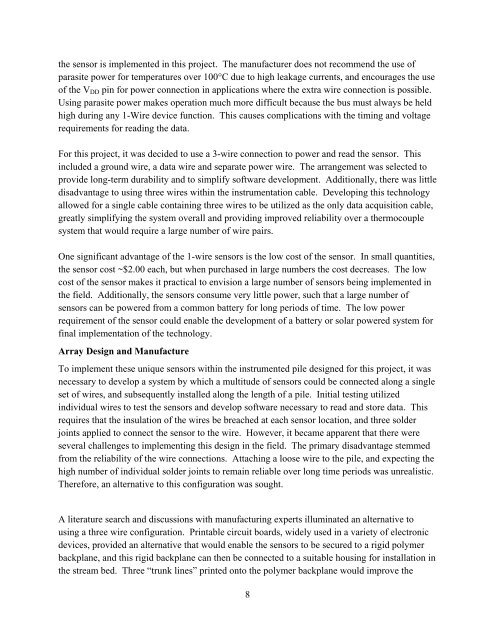Remote Health Monitoring for Asset Management
Remote Health Monitoring for Asset Management
Remote Health Monitoring for Asset Management
You also want an ePaper? Increase the reach of your titles
YUMPU automatically turns print PDFs into web optimized ePapers that Google loves.
the sensor is implemented in this project. The manufacturer does not recommend the use of<br />
parasite power <strong>for</strong> temperatures over 100°C due to high leakage currents, and encourages the use<br />
of the V DD pin <strong>for</strong> power connection in applications where the extra wire connection is possible.<br />
Using parasite power makes operation much more difficult because the bus must always be held<br />
high during any 1-Wire device function. This causes complications with the timing and voltage<br />
requirements <strong>for</strong> reading the data.<br />
For this project, it was decided to use a 3-wire connection to power and read the sensor. This<br />
included a ground wire, a data wire and separate power wire. The arrangement was selected to<br />
provide long-term durability and to simplify software development. Additionally, there was little<br />
disadvantage to using three wires within the instrumentation cable. Developing this technology<br />
allowed <strong>for</strong> a single cable containing three wires to be utilized as the only data acquisition cable,<br />
greatly simplifying the system overall and providing improved reliability over a thermocouple<br />
system that would require a large number of wire pairs.<br />
One significant advantage of the 1-wire sensors is the low cost of the sensor. In small quantities,<br />
the sensor cost ~$2.00 each, but when purchased in large numbers the cost decreases. The low<br />
cost of the sensor makes it practical to envision a large number of sensors being implemented in<br />
the field. Additionally, the sensors consume very little power, such that a large number of<br />
sensors can be powered from a common battery <strong>for</strong> long periods of time. The low power<br />
requirement of the sensor could enable the development of a battery or solar powered system <strong>for</strong><br />
final implementation of the technology.<br />
Array Design and Manufacture<br />
To implement these unique sensors within the instrumented pile designed <strong>for</strong> this project, it was<br />
necessary to develop a system by which a multitude of sensors could be connected along a single<br />
set of wires, and subsequently installed along the length of a pile. Initial testing utilized<br />
individual wires to test the sensors and develop software necessary to read and store data. This<br />
requires that the insulation of the wires be breached at each sensor location, and three solder<br />
joints applied to connect the sensor to the wire. However, it became apparent that there were<br />
several challenges to implementing this design in the field. The primary disadvantage stemmed<br />
from the reliability of the wire connections. Attaching a loose wire to the pile, and expecting the<br />
high number of individual solder joints to remain reliable over long time periods was unrealistic.<br />
There<strong>for</strong>e, an alternative to this configuration was sought.<br />
A literature search and discussions with manufacturing experts illuminated an alternative to<br />
using a three wire configuration. Printable circuit boards, widely used in a variety of electronic<br />
devices, provided an alternative that would enable the sensors to be secured to a rigid polymer<br />
backplane, and this rigid backplane can then be connected to a suitable housing <strong>for</strong> installation in<br />
the stream bed. Three “trunk lines” printed onto the polymer backplane would improve the<br />
8

















